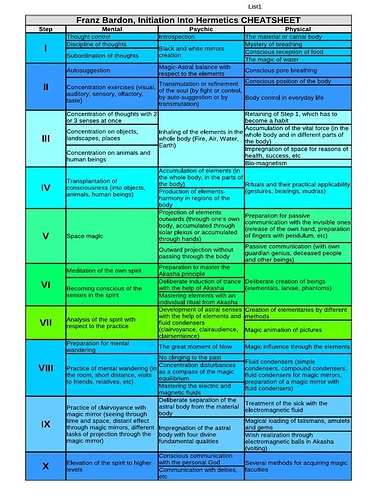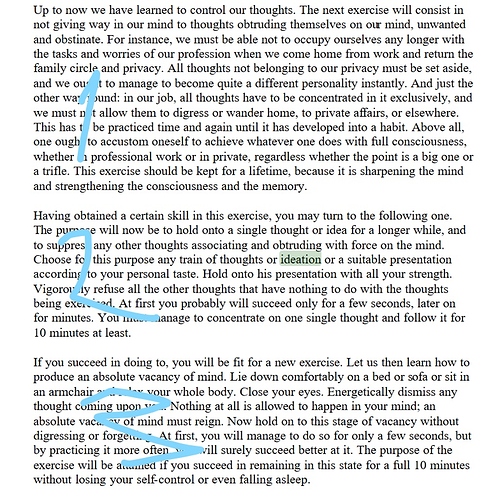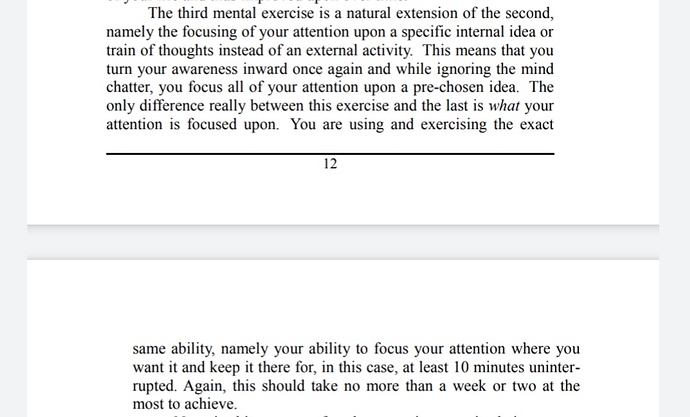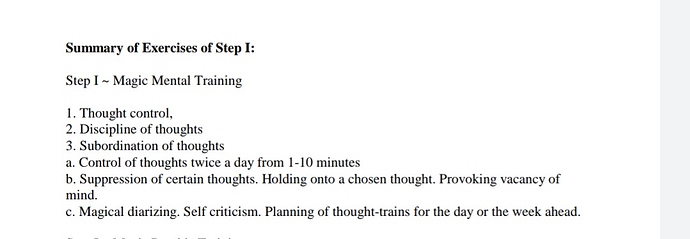Haha Frabato, what a book. Fun, but really poorly written.
Yeah, I think reading between the lines can teach you a lot of practical magic. Its like Castanedas works
Just to be clear, guys: the pdf copy I have is page 35 (Initiation Into Hermetics"), and we are told “the purpose will now be to hold onto a single thought or idea for a longer while, and to surpress any other thoughts associating and obtruding with force on the mind. Choose for this purpose any train of thoughts or ideation or a suitable presentation according to your personal taste. Hold onto his presentation with all your strength. Vigorously refuse all the other thoughts that have nothing to do with the thoughts being exercised.”
Thanks to all of you for your feedback so far.
Okay, you’re on exercise 2 of Step 1.
Have fun!
This is the guide to your step.
“The second type of meditation is titled “Thought Discipline” and has two phases of practice. The first phase is enacted in day-to-day life and involves disciplining your thoughts so that they pertain only to the task at hand. For example, if you’re driving to work, you practice the shunning of thoughts that have nothing to do with the act of driving. The second phase of the practice is performed as a normal meditation (i.e., sitting with your eyes closed). Here, one chooses a single thought and shuns the intrusion of all other thoughts. It is best, in this instance, to begin with a simple, captivating thought. Each time your mind wanders, bring it firmly back to the chosen thought.”
So yeah, using your example, only thoughts pertaining to the object should arise.
Excersise one
Take a seat in a comfortable chair or lie down on a settee. Relax the whole body, close your
eyes and observe the train of your thoughts for five minutes, trying to retain it. At first, you
will find that there are rushing up to you thoughts concerning everyday affairs, professional
worries, and the like. Take the behavior of a silent observer toward these trains of thoughts,
freely and independently. According to the mentality and the mental situation you happen to
be in at the moment, this exercise will be more or less easy for you. The main point is not to
forget yourself, not to lose the train of thoughts, but to pursue it attentively. Beware of falling
asleep while doing this exercise. If you begin to feel tired, stop instantly and postpone the
exercise to another time, when you intend not to give in to tiredness. The Indians sprinkle
cold water on their faces or rub down the face and upper part of their bodies to remain brisk
and not waste precious time. Some deep breathing before you begin will also prevent
tiredness and sleepiness. As time goes on, each disciple will find out such little tricks by
himself. This exercise of controlling thoughts has to be undertaken in the morning and at
night. It is to be extended each day by one minute to allow the train of thoughts to be pursued and controlled without the slightest digression for a time of 10 mi nutes at least after a week’s
training.
Excersise two
Up to now we have learned to control our thoughts. The next exercise will consist in not
giving way in our mind to thoughts obtruding themselves on our mind, unwanted and
obstinate. For instance, we must be able not to occupy ourselves any longer with the tasks and
worries of our profession when we come home from work and return the family circle and
privacy. All thoughts not belonging to our privacy must be set aside, and we ought to manage
to become quite a different personality instantly. And just the other way round: in our job, all
thoughts have to be concentrated in it exclusively, and we must not allow them to digress or
wander home, to private affairs, or elsewhere. This has to be practiced time and again until it
has developed into a habit. Above all, one ought to accustom oneself to achieve whatever one
does with full consciousness, whether in professional work or in private, regardless whether
the point is a big one or a trifle. This exercise should be kept for a lifetime, because it is
sharpening the mind and strengthening the consciousness and the memory.
Excersise three
Having obtained a certain skill in this exercise, you may turn to the following one. The
purpose will now be to hold onto a single thought or idea for a longer while, and to suppress
any other thoughts associating and obtruding with force on the mind. Choose for this purpose
any train of thoughts or ideation or a suitable presentation according to your personal taste.
Hold onto his presentation with all your strength. Vigorously refuse all the other thoughts that
have nothing to do with the thoughts being exercised. At first you probably will succeed only
for a few seconds, later on for minutes. You must manage to concentrate on one single thought and follow it for 10 minutes at least.
Again, you failed.
And finally, even A Bardon Companion confirms this.
Take a look at the the three exercises for Step 1 (Mental).
Again, you failed?!
Notice how OP’s exercise is aligned with Exercise 2.
Did you even read what he posted ahahahaha, that is the third excersise.
You are confusing focusing on daily tasks with single thought excersise.
Maybe you should try reading what he just posted.
I’m done talking to you. It’s crazy town in your head.
How many copy/pastes from the books and cheat sheet do I need to send you.
OP has confirmed it’s exercise 2 by liking my post.
What’s your problem now? You just want to be right? Okay, go and ask Rawn Clark and Franz Bardon to change the book to say Exercise 3 instead of 2.
OP also liked mine, awww, you wanted to be liked? 
Again, let me post you the third excersise of Rawn.
He says third.
“focusing your attention on a specific internal idea or TRAIN OF THOUGHTS”… so surely this means that if I focus on, say, an amethyst, and I then concentrate on things associated with that amethyst (say, where it is mined, etc), then I’d have thought I was doing it correctly?
I’d also really appreciate it if DarkestKnight could give feedback as well, if he could be so kind and happens to see this thread…
Man, the way you do it is by focusing on an amethyst, if it leads you somewhere other than amethyst, thats not fine, if it stays on amethyst, its.
I didnt say you are totally wrong but the way you worded it, was that you put additional thoughts on it.
In your first post you said
No, you tried to guide your thoughts,you added it, you shouldnt have.
So much confusion in this thread, lol.
Pg 68 of the actual book IIH, by Franz Bardon.
Exercise 2 of Step 1:
“This exercise is as follows: Retain one single thought or idea for a longer period of time while you steadfastly suppress all other thoughts which obtrusively try to join it. Select any idea or train of thoughts or any other suitable concept for this purpose at your own discretion. Retain this concept with all your power. Vigorously reject all other thoughts which have nothing to do with the one you are practicing…”
Exercise 3 of Step 1 is called “Mastery of Thoughts”. This is a totally different exercise. It’s vacancy of mind. Same page, pg 68.
“Vigorously reject any thought that attacks you. Nothing must be permitted to appear in your spirit or mind; only complete mental vacancy should prevail.”
The answer to your question is yes. In this exercise, you are cultivating the ability to focus on a thought or train of thought related to a single concept. This is done because it’s easier for the neophyte to focus on something rather than nothing. That’s why void meditation is the third exercise – to be done after you have gained competence in this second exercise.
So, if you pick amethyst, a valid train of thought might be: Where is amethyst mined? What does it look like? What does its color signify? How does it make me feel?
But a thought like: “onyx is pretty cool”, is out of bounds. It must be about amethyst itself.
What you said is on 34th page on my pdf, are you using an actual book, or a pdf? Maybe editions differ.
Ya that’s why you guys are confused. I’m reading from the actual book. Pg 34 in the actual book has theory. Actually really useful hermetic theory. I honestly would recommend anyone to work from the book itself. The theory is important.
We do have theory too.Now I get it, pdfs take more words into one page, let me show Bardons summary.
Holding onto a chosen thought, excersise 3, is what this guy is asking.It seems that guy and I use same pdf.Thanks for a good explanation without saying he should ignore what I am talking about. 
Haha no problem. You had valid points. It’s just that the IIH book is different from whatever PDF you have. For example, the summary of Step 1 in the actual book, pg 80:
“1. Magical Schooling of the Spirit
(1) Thought control. (2) Thought discipline. (3) Mastery of thoughts.
…
As to (2): Thought discipline; avoidance of particular thoughts that have arisen. Retention of a particular thought which you have chosen.
As to (3): The practice of vacancy of mind. Organizing a magical diary. Self-criticism. Planning and scheduling of thoughts for the next day or the coming week.”
Unfortunately, it seems the PDF you are working with is not faithful to the text of the book.
Thank you ever so much, veneficus. I really like the way you have explained it.



